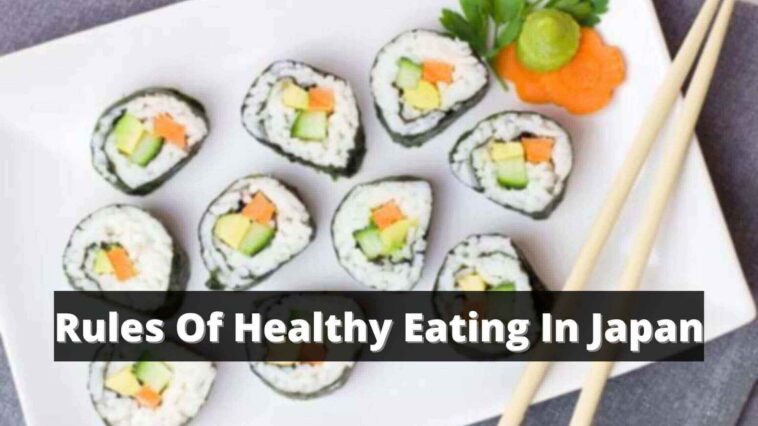Eating healthy in Japan can often be expensive. So here’s how to eat cheap and healthy in Japan. Read on to find out!
After having lived in Japan, I realised eating healthy in Japan is not very easy. Healthy eating can be very expensive in Japan. So based on my experience and time in Japan here’s how to eat cheap and healthy in Japan!
Eating healthy on a budget in Japan may seem challenging at first glance, given the nation’s reputation for exquisite cuisine and high living costs.
However, with some strategic planning and a bit of insight into the local dining culture, I’ve discovered that it is entirely possible to enjoy nutritious and affordable meals.

From the ubiquitous konbini (convenience stores) offering balanced bento boxes to the teishoku-ya (set meal restaurants) like Yayoiken and Ootoya, options for frugal foodies abound.
Navigating the dining scene requires understanding the varied menu options and nutritional information typical to Japanese cuisine.
Fortunately for health-conscious diners, Japanese meals tend to emphasize fresh ingredients and portion control, exemplified by the hara-hachibu principle, which advises eating until you’re 80% full.
By seeking out local eateries, opting for set meals, and embracing traditional Japanese eating habits, I have managed to keep my meals both healthful and economical.
Key Takeaways
- Cheap and healthy eating in Japan is achievable with knowledge of local dining options.
- Embracing traditional Japanese dietary practices promotes balanced and nutritious meals.
- Access to economical and wholesome food is facilitated by a mix of meal planning and cultural understanding.
Page Contents
How To Eat Cheap and Healthy In Japan?
To eat cheap and healthy in Japan, plan meals thoughtfully, and understand the structure of Japanese meals with a focus on staples like rice, seasonal vegetables, and varied proteins. Explore affordable options such as street food, chain restaurants, and konbini in Japan. Balance macronutrients with staples like rice and noodles, and prioritize micronutrient-rich foods like vegetables and fruits. Seek out vegetarian and vegan choices, explore local markets for fresh produce, and adopt local eating habits for a balanced diet on a budget.
Planning Your Meals
In Japan, a thoughtful approach to meal planning can enhance the dining experience while ensuring nutrition and cost-effectiveness.
Understanding Japanese Meal Structure
I believe recognizing the structure of healthy Japanese meals is paramount.
A typical Japanese dinner may consist of a main protein such as fish, meat, tofu, or sashimi, accompanied by a bowl of rice, miso soup, and various side dishes including vegetables and seaweed.
For lunch, a bento box provides a balanced meal with similar components, while udon or other noodles serve as both standalone meals and side dishes.
Japanese Breakfast often features a more modest spread with soup, rice, and small sides.
Incorporating Nutritious Japanese Staples
In my experience, the staples of a healthy Japanese diet balance satiety and nutrition.
Rice and noodles supply the necessary carbohydrates for energy.
I like to center my meals around seasonal vegetables and fruits for vitamins and minerals, and include a variety of protein sources such as fish, natto, and tofu for sustained energy.
Snacks often include onigiri (rice balls) or sliced fruit. I find that including seaweed adds not only a burst of flavor with minimal calories but also provides a rich source of minerals. I suggest seasoning dishes with soy sauce moderately to control sodium intake.
Eating on a Budget in Japan
In Japan, enjoying tasty meals while adhering to a budget is entirely possible. I’ll share some personal tips on where to find cheap yet healthy food options, touching on street food, restaurant chains, and supermarkets.
Cheap Eats and Street Food
I find that yatai, or street food stalls, offer an enticing array of affordable delicacies. You can savor everything from steaming hot ramen bowls to crispy tempura and savory gyoza.
Vegetables like moyashi (bean sprouts) and konjac often feature in these dishes, enhancing the meal with their health benefits without adding too much to the cost.
Street food provides not just a meal but also a slice of local flavor, especially during festivals or in areas like Osaka’s Dotonbori district.
Chain Restaurants and Fast Food Options in Japan
For a filling, budget-friendly meal, Japan’s chain restaurants come to the rescue.
Spots like Yoshinoya, Sukiya, and Matsuya serve up gyudon (beef bowl) that’s both inexpensive and tasty.
Coco Ichibanya offers a variety of curry dishes which you can customize with ingredients like maguro (tuna) or seafood.
If I’m craving a quick Western-style bite, Mos Burger provides a Japanese twist on burgers and fries, often incorporating elements like ponzu sauce or minimized use of MSG to cater to health-conscious diners.
Convenience Stores and Supermarkets in Japan
Convenience stores, or konbini, and supermarkets in Japan have an impressive selection of ready-to-eat meals. Here, you can pick up soba or udon noodles, curry packs, and even pre-packed sushi featuring fresh seafood.
As someone mindful of their budget and health, I often buy vegetarian options or Japanese staples such as onigiri (rice balls).
Moreover, these stores typically sell ingredients like moyashi and fresh tuna at reasonable prices, so you can whip up a simple yet nutritious meal on your own.
Nutritional Considerations
In Japan, maintaining a balanced diet while eating on a budget relies on understanding the nutritional content of readily available foods. I’ll focus on how to ensure that meals provide a full range of macronutrients and micronutrients.
Balancing Macronutrients
Japanese cuisine naturally lends itself to a balanced macronutrient profile. I’ve found that the staples of a Japanese diet like steamed rice or noodles offer complex carbohydrates that provide sustained energy throughout the day.
Proteins are equally important, and I prioritize sources such as fish and tofu for their low saturated fat content and high-quality protein.
For example, incorporating natto, a fermented soy product, not only adds protein to my diet but also delivers a unique flavor and texture.
- Carbohydrates: Steamed rice, noodles
- Proteins: Fish, tofu, natto
- Fats: Occasional use of healthy fats, such as those found in fish or lightly dressed salads
Incorporating Micronutrients
Micronutrients are vital for disease prevention and overall well-being. Vegetables like spinach and cabbage are my go-to for vitamins and minerals without adding significant cost to my diet.
I frequently use seaweed varieties such as wakame and nori in my meals for their iodine and trace mineral content. I often dress my dishes with a small amount of soy sauce to enhance flavor without compromising health benefits, mindful of its sodium levels.
Beyond this, I ensure that I consume a variety of fruits to obtain a spectrum of vitamins, minerals, and antioxidants.
- Vitamins & Minerals: Spinach, cabbage, wakame, nori
- Fruits: Seasonal selections for vitamins and antioxidants
- Soy Products: Tofu and natto for additional nutrients beyond protein
Cultural Aspects of Eating in Japan
In Japan, cultural traditions and etiquette significantly influence the dining experience, encapsulating the heritage and meticulous care put into each meal.
Traditional Japanese Eating Habits
I’ve observed that Japanese cuisine is a blend of taste, presentation, and nutrition, focusing heavily on seasonal and local food.
Meals often consist of a staple like steamed rice or noodles accompanied by an array of side dishes. The Japanese people have a deep appreciation for their culinary heritage, which can be seen in the widespread consumption of sushi and sashimi—both art forms in their own right.
The concept of kaitenzushi, or conveyor-belt sushi, makes sushi accessible and affordable.
In winter, oden—a type of hot pot—provides a variety of nutritious items simmering in a soy-flavored broth, ideal for warmth and health.
Onigiri, rice balls with various fillings, are a demonstration of culinary simplicity and portability, reflecting the efficiency cherished in Japanese society.
Additionally, during matsuri, or festivals, an array of unique street foods highlights the communal and celebratory aspects of eating.
Dining Etiquette and Practices in Japan
When I dine in Japan, adhering to proper etiquette is as important as the food itself.
At family restaurants and even more formal settings, it is customary to say “itadakimasu” before eating, expressing gratitude for the food.
Chefs take pride in their craft, and in places like sushi bars, interacting with the chef can enrich the dining experience.
It’s not uncommon to find tabehodai—all-you-can-eat plans—offering ample selections from Japanese curry to an assortment of sushi, promoting a communal and indulgent dining experience.
When engaging in such practices, it’s important to take only what one can finish to avoid waste— a reflection of Japanese values around food and respect.
Finding Healthy Options in Japan
In my experience navigating Japan’s food landscape, the key to discovering healthy meals is understanding what establishments offer and where to look for fresh, nutritious ingredients.
Vegetarian and Vegan Choices in Japan
As a vegetarian or vegan in Tokyo, exploring local supermarkets can yield a wealth of ingredients like nori, wakame, and konnyaku that are staples in Japanese cuisine and excellent for health-conscious diets.
Specialty stores and even mainstream grocers may have sections dedicated to plant-based foods, offering everything from mochi to seasoned sato, which are beans that can enrich your vegetarian or vegan meals.
Moreover, some restaurants in Tokyo cater specifically to these diets, ensuring a delightful dining experience without compromising on quality or taste.
Quality Restaurants and Food Selections
When looking for quality food, I’ve learned that it’s not just high-priced restaurants that serve healthy options.
Many affordable restaurants and teishoku-ya (set meal diners) provide a balanced meal often accompanied by a nutritious spread of side dishes for a reasonable price.
These meals often feature a main dish possibly including fish like octopus, accompanied by sides of local vegetables and rice, ensuring a wholesome and satisfying experience.
Patrons seeking quality restaurants can also find numerous eateries where healthy food is available without the need to spend extravagantly.
Eating Healthy in Japan: FAQs
In Japan, eating on a budget doesn’t mean you have to sacrifice nutrition. I’ll guide you through some common questions about maintaining a healthy diet economically.
What are some budget-friendly Japanese dishes that are also nutritious?
Japanese cuisine offers several nutritious and budget-friendly dishes, like soba noodles, which are rich in nutrients, and donburi, a rice bowl topped with vegetables and protein.
Where can I find affordable fresh produce in Japan?
Local farmers’ markets and small grocery shops often have competitive prices on fresh produce. Additionally, shopping in the evening may yield discounted prices as stores clear their perishable stock.
What options are available for low-calorie meals in Tokyo’s restaurants?
Many Tokyo restaurants offer set meals (teishoku) that include a balanced array of dishes in moderate portions. These meals are often lower in calories and focus on fresh, seasonal ingredients.
Can you suggest healthy Japanese snacks for someone on a tight budget?
Rice crackers (senbei) and seaweed snacks (nori) are not only light on the wallet but also low in calories. For a protein boost, edamame is an affordable and healthy choice.
How can you maintain a balanced diet in Japan without overspending?
Adopting local eating habits like the “hara hachibu” principle – eating until 80% full – can help maintain a balanced diet. Also, choosing seasonal produce and seafood can save money and provide essential nutrients.
What are the best high-protein, cost-effective food choices available in Japan?
Legumes like soybeans, found in tofu and natto, are affordable high-protein options. Eggs and local fish are also cost-effective sources of protein widely available in Japan.
Also Read:





